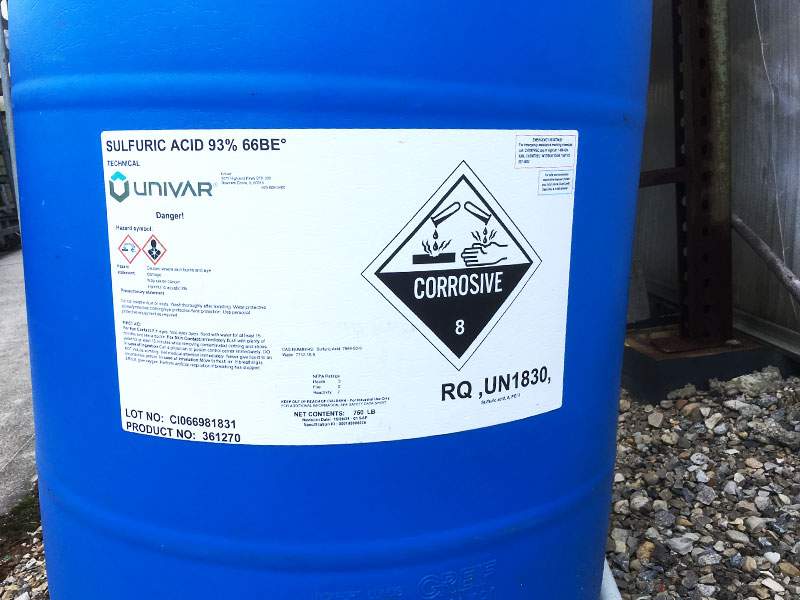How Much Acid Is Needed to Reduce Water Alkalinity?


To limit the upward climb of your growing medium's pH, you may need to inject acid into your water to reduce excess alkalinity. Water alkalinity measures the carbonates and bicarbonates in the water and acts just like limestone in the growing medium.
The higher the alkalinity, the more “limestone” is applied at each irrigation and the faster the pH of your growing medium increases. So, at what point is it necessary to inject acid into a water source to reduce alkalinity?
Why is The Growing Medium's pH Rising?
As plants uptake fertilizer, the roots release acids (hydrogen ions) and bases (hydroxyl ions) to maintain a neutral charge within the plant's roots. This is why fertilizers are labelled with a potential acidity or basicity that predicts how the plant will react with the fertilizer.
When the plant cannot generate enough acid from fertilizer uptake to neutralize the water alkalinity in the growing medium, this causes the growing medium's pH to climb. Therefore, acid injection is needed to neutralize excess water alkalinity or “limestone” in the water.

The point at which acid injection is required will vary depending on the stage of plant development, the fertilizer analysis and the quantity of fertilizer the plant uses. For example, a heavy feeder, like a petunia, uses a lot of fertilizer during its active growth phase and can produce a lot of acid to drop the growing medium's pH. However, a small petunia seedling uses very little fertilizer and therefore produces little acid. For a grower rooting cuttings or producing plugs, the alkalinity of the water must be lower than for a grower transplanting plugs or rooted cuttings into larger pot sizes. So, what are the recommended thresholds at which acid injection is required?
General Guidelines for Acid Injection
Table 1 shows the general recommendations that can be used to determine when acid should be injected based on the container size and water alkalinity. These are general guidelines, but the type of fertilizer used is not considered in these guidelines. Table 2 provides more specific guidelines as it considers the fertilizer applied. Remember that a potentially basic fertilizer, when used by the plant, will generate alkaline materials and thus increase the pH of the growing medium.
| Crop | Manageable alkalinity ppm CaCO3) | Alkalinity threshold for injecting acid (ppm CaCO3) |
|---|---|---|
| Plugs, seedlings, cuttings | 30-80 ppm | > 125 ppm |
| Cell packs | 50-180 ppm | > 200 ppm |
| 4-6 inch pots | 50-200 ppm | > 225 ppm |
| Baskets, large containers | 50-225 pp, | > 250 ppm |
| Crop | Alkalinity threshold for injection acid when using the following fertilizers (measured in ppm CaCO3): | |||
|
13-2-13 (Potential basicity 223 lb CaCO3) |
17-5-17 (Potential acidity 59 lb CaCO3) |
20-10-20 (potential acidity 400 lb CaCO3) | 18-9-18 (Potential acidity 700 lb CaCO3) | |
| Plugs, seedlings, cuttings | 50 ppm CaCO3 | 80 ppm CaCO3 | 125 ppm CaCO3 | 150 ppm CaCO3 |
| Cell packs | 80 ppm CaCO3 | 100 ppm CaCO3 | 200 ppm CaCO3 | 250 ppm CaCO3 |
| 4-6 inch pots | 100 ppm CaCO3 | 125 ppm CaCO3 | 225 ppm CaCO3 | 300 ppm CaCO3 |
| Baskets, large containers | 120 ppm CaCO3 | 150 ppm CaCO3 | 250 ppm CaCO3 | 325 ppm CaCO3 |
As seen in Table 2, the higher the potential acidity of the fertilizer, the more water alkalinity can be handled by a crop. In other words, a water-soluble fertilizer can help manage the pH of the growing medium. If the pH of your growing medium tends to increase, perhaps the first option is to switch to a fertilizer with a higher potential acidity. If the alkalinity of your water exceeds those listed for the crop grown, then acid can be injected.

Reduce, Not Eliminate
Notice in Tables 1 and 2, the goal is not to eliminate all the water alkalinity, but to reduce it to manageable levels. Neutralizing the alkalinity to 0 ppm CaCO3 will reduce the water's pH to the point it can damage roots near the surface of the growing medium and interfere with seed germination. It can also create fluctuations in the growing medium's pH and problems with pH buffering after the lime charge has been used up.
Note: Since Premier Tech does not manufacture acidifiers, we invite you to consult your manufacturer for specific information concerning the use of their products.